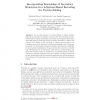Free Online Productivity Tools
i2Speak
i2Symbol
i2OCR
iTex2Img
iWeb2Print
iWeb2Shot
i2Type
iPdf2Split
iPdf2Merge
i2Bopomofo
i2Arabic
i2Style
i2Image
i2PDF
iLatex2Rtf
Sci2ools
AE
2005
Springer
2005
Springer
Incorporating Knowledge of Secondary Structures in a L-System-Based Encoding for Protein Folding
An encoding scheme for protein folding on lattice models, inspired by parametric L-systems, was proposed. The encoding incorporates problem domain knowledge in the form of predesigned production rules that capture commonly known secondary structures: α-helices and β-sheets. The ability of this encoding to capture protein native conformations was tested using an evolutionary algorithm as the inference procedure for discovering L-systems. Results confirmed the suitability of the proposed representation. It appears that the occurrence of motifs and sub-structures is an important component in protein folding, and these sub-structures may be captured by a grammar-based encoding. This line of research suggests novel and compact encoding schemes for protein folding that may have practical implications in solving meaningful problems in biotechnology such as structure prediction and protein folding.
| Added | 26 Jun 2010 |
| Updated | 26 Jun 2010 |
| Type | Conference |
| Year | 2005 |
| Where | AE |
| Authors | Gabriela Ochoa, Gabi Escuela, Natalio Krasnogor |
Comments (0)

